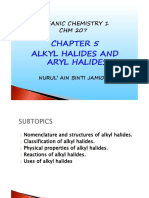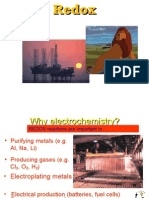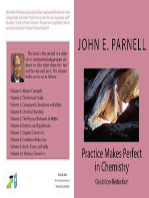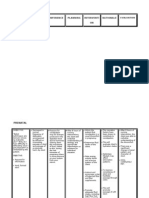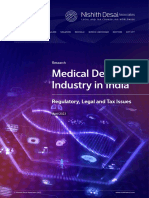0 ratings0% found this document useful (0 votes)
119 viewsChain Polymerization Free Radical Polymerization
Chain Polymerization Free Radical Polymerization
Uploaded by
bishnukoiryThis document describes the process of free radical polymerization. It involves three main stages: initiation, propagation, and termination. In initiation, free radicals are formed using heat, light, or redox reactions to break bonds on initiator molecules. Propagation involves these free radicals adding monomers to the growing polymer chain. Termination occurs when two growing chains combine or one transfers a hydrogen to another, stopping further growth. Overall, free radical polymerization is a chain reaction where polymer molecules grow through the continuous addition of monomers.
Copyright:
© All Rights Reserved
Available Formats
Download as PPT, PDF, TXT or read online from Scribd
Chain Polymerization Free Radical Polymerization
Chain Polymerization Free Radical Polymerization
Uploaded by
bishnukoiry0 ratings0% found this document useful (0 votes)
119 views10 pagesThis document describes the process of free radical polymerization. It involves three main stages: initiation, propagation, and termination. In initiation, free radicals are formed using heat, light, or redox reactions to break bonds on initiator molecules. Propagation involves these free radicals adding monomers to the growing polymer chain. Termination occurs when two growing chains combine or one transfers a hydrogen to another, stopping further growth. Overall, free radical polymerization is a chain reaction where polymer molecules grow through the continuous addition of monomers.
Original Title
1496_l07.ppt
Copyright
© © All Rights Reserved
Available Formats
PPT, PDF, TXT or read online from Scribd
Share this document
Did you find this document useful?
Is this content inappropriate?
This document describes the process of free radical polymerization. It involves three main stages: initiation, propagation, and termination. In initiation, free radicals are formed using heat, light, or redox reactions to break bonds on initiator molecules. Propagation involves these free radicals adding monomers to the growing polymer chain. Termination occurs when two growing chains combine or one transfers a hydrogen to another, stopping further growth. Overall, free radical polymerization is a chain reaction where polymer molecules grow through the continuous addition of monomers.
Copyright:
© All Rights Reserved
Available Formats
Download as PPT, PDF, TXT or read online from Scribd
Download as ppt, pdf, or txt
0 ratings0% found this document useful (0 votes)
119 views10 pagesChain Polymerization Free Radical Polymerization
Chain Polymerization Free Radical Polymerization
Uploaded by
bishnukoiryThis document describes the process of free radical polymerization. It involves three main stages: initiation, propagation, and termination. In initiation, free radicals are formed using heat, light, or redox reactions to break bonds on initiator molecules. Propagation involves these free radicals adding monomers to the growing polymer chain. Termination occurs when two growing chains combine or one transfers a hydrogen to another, stopping further growth. Overall, free radical polymerization is a chain reaction where polymer molecules grow through the continuous addition of monomers.
Copyright:
© All Rights Reserved
Available Formats
Download as PPT, PDF, TXT or read online from Scribd
Download as ppt, pdf, or txt
You are on page 1of 10
CHAIN POLYMERIZATION
Free Radical Polymerization
Free radical are independently-existing species that have
unpaired electron. Normally they are highly reactive
with short life time.
Free radical polymerizations are chain polymerizations
in which each polymer molecules grows by addition of
monomer to a terminal free-radical reactive site known
as active center.
After each addition the free radical is transferred to the
chain end.
Chain polymerization is characterized by three distinct
stages, Initiation, propagation and termination.
Example
The formation of polyvinyl monomer.
CH
2
= CHX
INITIATION
This stage is a two steps stage
1. The formation of free radicals from an
initiator.
2. The addition of one of these free radicals to a
monomer molecules.
Free radical can be formed by two principal
1. Homolytic scission (homolysis) or breakage of
a single bond.
2. Single electron transferred to or from an ion
or molecule (redox reactions)
Homolytic can be achieved by heat (thermolysis)
or by light such as U.V. (photolysis).
Example
Sometimes the radicals undergo further breakdown (-
scissions) such as
O O O
-C-0-0-C- 2 -C-O
Benzoly peroxide Benzolyooxy radicals
(CH
3
)
2
C-N = N- C (CH
3
)
2
2(CH
3
)
2
C + N
2
CN CN CN
Azobisisobutyronitril 2-Cyanopropyl radicals
O O
-C-0 + C = O
(CH
3
)
2
- C-O CH
3
+ (CH
3
)
2
-C = 0
CH3 Methyl acetone
radical
PHOTOLYSIS
Photolysis is the second principle of free
radical formation.
The advantage of this method is that the
formation of free radicals begins at the
instant of exposure and cases as soon as
the light source is removed.
REDOX REACTION
Redox reaction defined as the generation of free
radicals by electron transfer and it is use when
polymerization performed at low temperature.
Example
CH
3
CH
3
-C-0-0H + Fe
2+`
-C-O + OH + Fe
3+
CH
3
CH
3
Cumyl Ferrous Cumyloyloxy
hydroperoxide ion radical
O O O O O O
O-S-O-O-S-O + HO-S-O 0-S-O + O-S-O + OH-S-O
O O O O
Presulphate Bisulphate Sulphate Sulphate Bisulphate
ion ion ion radical radical
An active center is crated when a free radical (R
o
)
which is generated from an initiator attacks the -bond
of the monomer molecules.
R + CH
2
= CH R-CH
2
-CH or R-CH - CH
2
X X X
This is more This is more
likely stable
Sometime free radical react with each other such as:
O O O
2 -C-0 -C-O- + C = O
OR
2
PROPAGATION
The addition of monomer molecules to the active center to grow
the polymer chain.
There are two modes of chain propagation
Again mode (1) are more dominant.
Time of addition for each monomer is of the order of a millisecond.
Thus several thousands of additions can take place in a few seconds.
Therefore polymer structure are like
-----CH
2
-CH-CH
2
-CH-CH
2
-CH-CH
2
-CH------
X X X X
1. Head to Tail
R-CH
2
-CH + CH
2
=CH R-CH
2
-CH-CH
2
-CH
X X X X
2. Head to Head
R-CH
2
-CH + CH
2
=CH R-CH
2
-CH-CH-CH
2
X X X X
TERMINATION
The last stage of chain reaction in which the growth of
the polymer chain terminated (or stopped).
There are two mechanisms of termination
1. Combination
Coupling together of two growing chains to form a
single polymer molecules. polystyrene
2. Disproportionation
when a hydrogen atom move from one growing chain to
another
--CH
2
-CH + CH - CH
2
--- ---- CH
2
-CH- CH-CH
2
---
X X X X
H H
--CH
2
-CH + C - C--- ----CH
2
-CH
2
+ CH=CH
2
---
X X H X X
Saturated end Unsaturated end
group polymer group polymer
Thank You
See You Next Lecture
You might also like
- Detailed Answer Key Houston Leadership 0316: Created On:02/09/2020Document14 pagesDetailed Answer Key Houston Leadership 0316: Created On:02/09/2020Rose OcampoNo ratings yet
- Schaum's Easy Outline of Organic Chemistry, Second EditionFrom EverandSchaum's Easy Outline of Organic Chemistry, Second EditionRating: 3.5 out of 5 stars3.5/5 (2)
- Laptops For Teachers App 1 Sample Staff User AgreementDocument6 pagesLaptops For Teachers App 1 Sample Staff User AgreementAhsanAliNo ratings yet
- Universal 12 Week Bodybuilding Course PDFDocument111 pagesUniversal 12 Week Bodybuilding Course PDFHyperionGANo ratings yet
- Graves DiseaseDocument35 pagesGraves DiseaseMarianGadugdug75% (4)
- Case Study - Ectopic PregnancyDocument10 pagesCase Study - Ectopic Pregnancykristine keen buanNo ratings yet
- Free Radical PolymerizationDocument11 pagesFree Radical PolymerizationNaveed AhmadNo ratings yet
- Unit IDocument39 pagesUnit IGoopNo ratings yet
- Mass Spectroscopy 1Document55 pagesMass Spectroscopy 1thandarthandarwin1991No ratings yet
- Disha Publication Reaction-Mechanism PDFDocument101 pagesDisha Publication Reaction-Mechanism PDFSridhar Marella50% (2)
- Fundamentals of Polymer Chemistry Radical PolymerizationDocument76 pagesFundamentals of Polymer Chemistry Radical PolymerizationkNo ratings yet
- Mass SpectrometryDocument55 pagesMass Spectrometrythandarthandarwin1991No ratings yet
- Mass SpecDocument42 pagesMass SpecChilotaw MulukenNo ratings yet
- Polymer Materials PDFDocument64 pagesPolymer Materials PDFGajendran PandiNo ratings yet
- Mass Spectrometry Parts of Elucidation StructureDocument52 pagesMass Spectrometry Parts of Elucidation StructureGina Fajar AndiniaNo ratings yet
- Very Strong: Carbanions, R Carbocations, RDocument11 pagesVery Strong: Carbanions, R Carbocations, RSandeep ThakurNo ratings yet
- 5.2 Alkil Halydes Rev 1kaliDocument88 pages5.2 Alkil Halydes Rev 1kalikukuh septaNo ratings yet
- 187 Avoidable Errors in Reaction Mechanism QuestionsDocument4 pages187 Avoidable Errors in Reaction Mechanism QuestionsM DiNo ratings yet
- Lecture 4 - Ionic Polymerization-2Document22 pagesLecture 4 - Ionic Polymerization-2Lester John VeraNo ratings yet
- Chem120 Part 1Document59 pagesChem120 Part 1sibonginkosimagudulelaNo ratings yet
- Polym ReactDocument8 pagesPolym ReactPradeep KumarNo ratings yet
- Substitution Elemination Reactions 1Document32 pagesSubstitution Elemination Reactions 1oureducation.inNo ratings yet
- Topic 10 Alkane TutorialDocument6 pagesTopic 10 Alkane TutorialTimNo ratings yet
- Polymer DegradationDocument6 pagesPolymer Degradationrifat.seutextileNo ratings yet
- Organometallics and Catalysis - IVDocument36 pagesOrganometallics and Catalysis - IVankit guptaNo ratings yet
- Substitution Elimination (Alkilhalides) Bab 5 FessendenDocument113 pagesSubstitution Elimination (Alkilhalides) Bab 5 Fessendenahmad jamalNo ratings yet
- chm207 chp5Document92 pageschm207 chp5Muhd Mirza HizamiNo ratings yet
- Complete GOC in One Shot by Singh SahabDocument122 pagesComplete GOC in One Shot by Singh Sahabhackr6828No ratings yet
- RecapDocument10 pagesRecapf20213135No ratings yet
- Class 2Document21 pagesClass 2j72pkpj2ydNo ratings yet
- Oxidation-Reduction Reactions (Electrochemistry) : The Material On These Slides Are Taken From (With Some Modifications)Document63 pagesOxidation-Reduction Reactions (Electrochemistry) : The Material On These Slides Are Taken From (With Some Modifications)Hendri KurniawanNo ratings yet
- 2016 Lect6a Substitution Elimination (Alkilhalides)Document144 pages2016 Lect6a Substitution Elimination (Alkilhalides)Bryan SuryapranataNo ratings yet
- This PDF Is The Sample PDF Taken From Our Comprehensive Study Material For IIT-JEE Main & AdvancedDocument13 pagesThis PDF Is The Sample PDF Taken From Our Comprehensive Study Material For IIT-JEE Main & AdvancedGod is every whereNo ratings yet
- Ms Interpretation2013Document72 pagesMs Interpretation2013Leandro PereiraNo ratings yet
- Chapter 8 Redox ReactionsDocument23 pagesChapter 8 Redox Reactionsapi-19916399No ratings yet
- CHAPTER 4-Carboxylic Acids DerivativesDocument20 pagesCHAPTER 4-Carboxylic Acids Derivativesshahera rosdiNo ratings yet
- Chapter 1Document9 pagesChapter 1skywalkerNo ratings yet
- Module 3 Class 4 J BatchDocument20 pagesModule 3 Class 4 J BatchVedurupaka Venkata SaiNo ratings yet
- Chapter 3 Alkenes and Alkynes New-1Document63 pagesChapter 3 Alkenes and Alkynes New-1Nafees AliNo ratings yet
- ElectrochemistryDocument60 pagesElectrochemistryAthule Ewur-pentsilNo ratings yet
- HaloalkanesDocument12 pagesHaloalkanesMo_Bash1No ratings yet
- Module9 PDFDocument22 pagesModule9 PDFBaban BaidyaNo ratings yet
- Discussed in AlkenesDocument29 pagesDiscussed in AlkenesRit WickNo ratings yet
- Class XII - All India Chemistry - Set-2: Alkyl Halide Sodium Alkoxide EtherDocument4 pagesClass XII - All India Chemistry - Set-2: Alkyl Halide Sodium Alkoxide EtherShashank ShekharNo ratings yet
- AnalysisDocument5 pagesAnalysisAnuki PereraNo ratings yet
- Reaction Mechanisms GOC BookDocument84 pagesReaction Mechanisms GOC BookAyushNo ratings yet
- General Organic Chemistry - Final PDFDocument70 pagesGeneral Organic Chemistry - Final PDFMalati PradhanNo ratings yet
- Reactions of Oils and FatsDocument34 pagesReactions of Oils and FatsMuhammad Miqsal SholihiNo ratings yet
- Important Long and Short Answer Questions For EC Exam-Dr Mallesham GDocument7 pagesImportant Long and Short Answer Questions For EC Exam-Dr Mallesham Gshivamani1489No ratings yet
- +1 Chemistry - Some Important Questions & Answers PART 2Document12 pages+1 Chemistry - Some Important Questions & Answers PART 2ahammedkayangalkayangalNo ratings yet
- E1 and E2 ReactionsDocument30 pagesE1 and E2 ReactionsVidhu Pandey100% (1)
- 10:9:23 + 10:11 Chem 14D Lecture 4Document19 pages10:9:23 + 10:11 Chem 14D Lecture 4maryam.alturkii22No ratings yet
- Foundations of A'level Chemistry Organic by G KatumbDocument120 pagesFoundations of A'level Chemistry Organic by G Katumbtroublemusic999No ratings yet
- Chapter 7 PDFDocument80 pagesChapter 7 PDFBaban BaidyaNo ratings yet
- MG University MSC Chemistry CH500202 ORGANIC REACTION MECHANISMS Scheme July 2017Document34 pagesMG University MSC Chemistry CH500202 ORGANIC REACTION MECHANISMS Scheme July 2017anoopNo ratings yet
- Kinetics of Radical PolymerizationDocument75 pagesKinetics of Radical Polymerizationania20011No ratings yet
- HaloalkanesDocument46 pagesHaloalkanesPrashant ZadeNo ratings yet
- Chemical Engineering 160/260 Polymer Science and EngineeringDocument33 pagesChemical Engineering 160/260 Polymer Science and EngineeringJay SteeleNo ratings yet
- RedoxDocument41 pagesRedoxNauval ZidnyNo ratings yet
- Module 4Document158 pagesModule 4Sreedevi KrishnakumarNo ratings yet
- Mole Concept 2 Theory EDocument23 pagesMole Concept 2 Theory EAnu Radha100% (2)
- Practice Makes Perfect in Chemistry: Oxidation-ReductionFrom EverandPractice Makes Perfect in Chemistry: Oxidation-ReductionRating: 5 out of 5 stars5/5 (1)
- Practice Makes Perfect in Chemistry: Oxidation-Reduction with AnswersFrom EverandPractice Makes Perfect in Chemistry: Oxidation-Reduction with AnswersNo ratings yet
- Digital Portable Power Clamp Harmonics KM 2709Document2 pagesDigital Portable Power Clamp Harmonics KM 2709industrialindia1No ratings yet
- 1093 Inhalational-AnaestheticsDocument50 pages1093 Inhalational-Anaestheticsvps criticareNo ratings yet
- Prenatal NCPDocument3 pagesPrenatal NCPErmi Tañio100% (2)
- 05-Saadiyat Itp (Backfilling) VillaDocument4 pages05-Saadiyat Itp (Backfilling) VillasoorajNo ratings yet
- General EducationDocument2 pagesGeneral EducationApril Joyce Narciso ArceoNo ratings yet
- Accelerated Curing Tanks - Concrete Curing - Utest Material Testing EquipmentDocument2 pagesAccelerated Curing Tanks - Concrete Curing - Utest Material Testing EquipmentPritha DasNo ratings yet
- Greige Issue Sept 2014Document92 pagesGreige Issue Sept 2014AzaddwNo ratings yet
- 8th Revup PersonsDocument59 pages8th Revup PersonsPatrice De CastroNo ratings yet
- Cable Laoding DetailsDocument1 pageCable Laoding DetailsAkd DeshmukhNo ratings yet
- Abruptio Placenta: Prepared By: Claire Alvarez Ongchua, RNDocument42 pagesAbruptio Placenta: Prepared By: Claire Alvarez Ongchua, RNclaireaongchua1275100% (3)
- Environmental Resistance and Mechanical Performance of Basalt and Glass FibersDocument8 pagesEnvironmental Resistance and Mechanical Performance of Basalt and Glass FibersmithileshmaverickNo ratings yet
- WV0800-0001-E Cleaning of Conductor RailsDocument14 pagesWV0800-0001-E Cleaning of Conductor RailsbassledsNo ratings yet
- Bemifix CRW: Product Information SheetDocument2 pagesBemifix CRW: Product Information SheetmhzraufNo ratings yet
- Polyphenols of OnionDocument6 pagesPolyphenols of OnionssmaniNo ratings yet
- Medical Device IndustryDocument74 pagesMedical Device IndustryStevesmart SteveNo ratings yet
- ParacetamolDocument2 pagesParacetamolLegendX100% (1)
- Basdev VS State of Pepsu: Citation:1956 AIR 488, 1956 SCR 363Document10 pagesBasdev VS State of Pepsu: Citation:1956 AIR 488, 1956 SCR 363shivam malikNo ratings yet
- FLUOROURACILDocument2 pagesFLUOROURACILArtem KulikovNo ratings yet
- Dof-Train With TrabahoDocument56 pagesDof-Train With TrabahoMariver LlorenteNo ratings yet
- Acme ProfileDocument12 pagesAcme ProfileKhushi Mayank AgarwalNo ratings yet
- The Mechanically Extraction Process From Leaves and Twigs of Gambier (Uncaria Gambier Roxb) and Its Antioxidant ActivityDocument8 pagesThe Mechanically Extraction Process From Leaves and Twigs of Gambier (Uncaria Gambier Roxb) and Its Antioxidant Activity18O1125 ELIEN SUKMAWATINo ratings yet
- Alligator: Animal Male Female Baby Group of AnimalsDocument16 pagesAlligator: Animal Male Female Baby Group of AnimalsyaminiNo ratings yet
- Jsa Bitumen Heating, Lying at DahejDocument6 pagesJsa Bitumen Heating, Lying at DahejJayavant LoharNo ratings yet
- Introduction To Debate, HandoutDocument1 pageIntroduction To Debate, HandoutRj BallNo ratings yet
- Mil STD 2175aDocument34 pagesMil STD 2175aYasser Hammad MohamedNo ratings yet


























